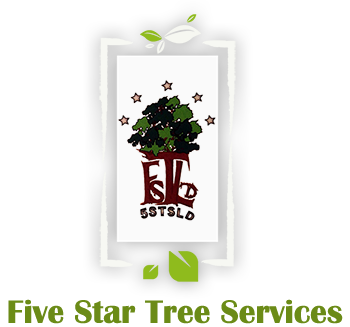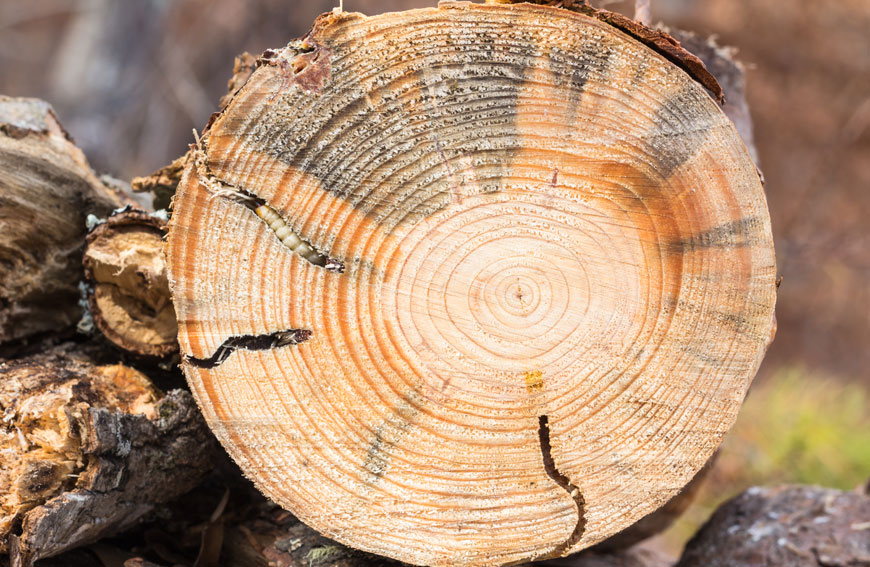Tree pests can come in many different types, shapes and sizes. A pest can be considered both a disease or an insect. It’s basically defined as anything that negatively affects trees in urban areas and forests. There are certain warning signs and symptoms that you should be aware of in order to properly protect and save your trees from these pests. Our team at Five Star Tree Services has come up with a list of the most common pests you might find on your trees.
Tent Caterpillars
Also known as Eastern Tent Caterpillars, these insects like to make nests made of silk webs in the tree branches. When the caterpillars grow, they have a voracious appetite and can defoliate the leaves from trees very quickly. Their favorite tree to nest in and eat are apple and cherry trees, from the rose family.
More often than not, the trees will survive the feeding frenzy and regrow new leaves. However, it takes a lot of the tree’s energy to do so, which can cause a lot of stress on the tree. So, depending on how big and old the tree is, it might have devastating effects and kill the tree. Luckily, there are numerous ways that you can help to control these outbreaks. This can include sticking sticky traps around each tree in order to prevent crawling up the tree to the crown and nesting/feeding. You can also use Bacillus thuringiensis, or BT for short, which is a bacterium commonly used in organic agriculture that will kill the caterpillars. One more option is to locate the nest and remove it from the tree.
Tar Spots
Also known as Rhytisma acerinum, is a fungal infection that can pop up between the middle of summer and the fall. You can notice this in the leaves, where pale spots formed and then turned black or dark brown.
These typically trees targeted are species of sycamore and maples. The most common tree it is found in are Norway maples. However, it can also be found on red and silver maples. Luckily, it does little harm to the tree and only really looks ugly. To limit the growth, in the fall, make sure to remove all the infected leaves from around the base of the tree. This will help to stunt the growth and spread for the following year.
Anthracnose
This is a common wet spring fungal infection. The signs of this infection are that a tree’s leaves will curl, turn black, and then fall off. Primarily affecting new growth, as it happens in the spring, this disease is able to survive on the fallen diseased leaves and spread through these fallen leaves.
The one good thing about this is that anthracnose is not known to kill trees on its own. However, depending on the age and size of a tree, the energy required in order to produce new leaves can put a lot of stress on it. It is important to clean up all the fallen leaves and debris to prevent it from spreading or returning the next year. You should also avoid any watering to infected trees, this will also help to prevent it coming back the next year.
Black Knot
This is a very aggressive fungus also known as Apiosporina morbosa. It mainly targets fruit bearing species like plumb and cherry trees. The way to notice this fungus is by the swollen black growths that will appear on the branches of the trees. In the early stages it is merely ugly and affects the aesthetic appearance of a tree. But if left alone, it will eventually take over the tree and kill it.
One way to effectively manage this fungus is to prune back the affected branches. You will need to be careful not to reinfect the tree with the cut branches. To properly cut out the fungus, you need to remove all infected branches far below the visible swollen black masses. Once done, make sure to sterilize your tools to ensure you don’t spread the fungus to the next tree you cut.
An easy way to do this is with bleach or Lysol wipes. You should wipe them after each cut, whether you use a saw or pruners. Make sure to thoroughly prune each tree and when finished, disinfect all your tools you used. Put all the infected clippings in a garbage bag and make sure to tie it tightly so that nothing can get out and travel to other trees.
For best results and to not hurt the tree, you should prune during dormant times. This will also help to prevent the spores from re-infecting the tree and infecting other trees.
Hemlock Woolly Adelgid
This is an insect that looks like an aphid and it likes to eat the needle base tissues of Hemlocks. Found in the 1950’s in Eastern US, it has now spread into Eastern Canada. But there have been sightings of infested trees in Niagara Falls and as far as Ottawa. The infestation has been taken care of and eliminated in Niagara Falls but could still remain in Ottawa.
This pesky insect can be transferred by wood products bought by people, the wind, or animals. These particular insects do not need a male partner in order to reproduce, and they do so asexually. You can identify an infected tree by the following:
-needle loss
-white woolly sacs that you can find at the base of needles and twigs in the spring
-early bud/twig dieback
-thinning/dull crown
It is possible for death to occur between 5-15 years. Unfortunately, there aren’t many control measures in Canada since these are relatively new insects infiltrating Canada. If you believe that you might have a Hemlock Woolly Adelgid infestation, contact professionals to properly identify it and then contact the Canadian Food Inspection Agency and report the tree.
Beech Bark Disease
This disease has two components to it. Beach Scale or Cryptococcus and canker fungus, or Neonectria faginata. It can be spread from wood movement, animals, and by wind. First it starts with a scale infestation and then the fungus is able to infect the tree from the open wounds. When this happens, it causes deformities and severe cankers that eventually lead to death. When a tree has BBD, this causes severe weakening which makes them extremely hazardous. Even if some trees look like they are in ok shape, if they get BBD, they can easily fall apart or fall over.
BBD Symptoms include:
-Thinning crown
-The fungus will have small orange/red fruiting bodies that you can see during the summer and fall
-Yellowing, wilting, or small foliage
-The first affected are usually mature trees
-Fuzzy white substances on the branches caused by the scale
-Low vigor
Unfortunately, there is no cure. Therefore, in order to help stop the spread, do not move beech wood. So, if you believe a tree on your property has BBD, you should call your local arborist to come and assess and identify if this is the case. The next step would be to try and proactively remove any and all hazardous trees from your property so that they don’t fall.
Emerald Ash Borer
This is a type of beetle that originated from Asia. Since its accidental introduction to North America around 2001, it has caused the devastation and death of millions of Ash trees. Unfortunately, not much can be done about this beetle and there are no preventative measures you can take to stop a tree from being infested and dying. There are some injectable treatments but they offer limited protection and ultimately don’t work to save the tree. If you notice this beetle, it’s imperative that you avoid moving the infested wood. In order to control the fast spread of these beetles, have an arborist properly remove them from your property.
How Five Star Tree Service Can Help
If you believe that your trees are suffering from some kind of pest, make sure to give us a call today at (416) 990-3355. We would be happy to send out our highly skilled and experienced team from Five Star Tree Services to assess the situation, confirm if and what type of pest you have, and come up with an appropriate plan to help your trees and remove the pests properly.


